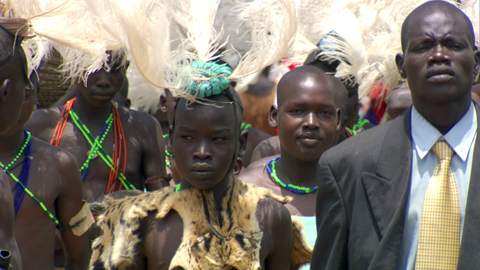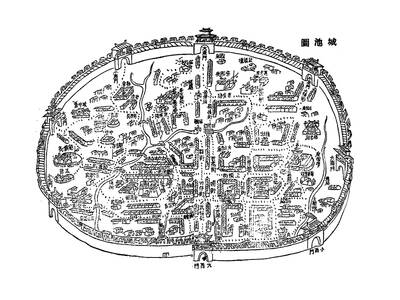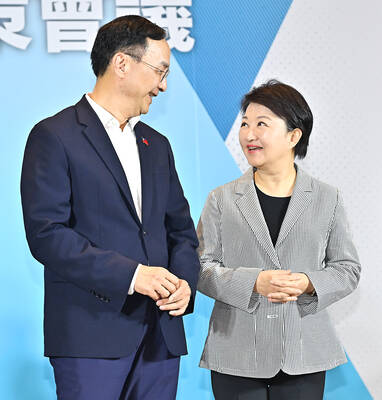War/Dance depicts kids from a war zone who go to the big city to dance for awards. A dancer, a choir singer and a xylophone player share their joy of expression with filmmakers who are just as expressive with their cameras.
Husband-and-wife co-directors Sean Fine and Andrea Nix Fine build a beautiful documentary from elements often favored by nonfiction filmmakers: a hot spot racked with bloodshed, orphans in refugee camps, ravishing scenery and the uplift of watching underdogs onstage vying for the big prize. War/Dance combines all these elements to personalize Uganda’s 20-year civil war and reach transcendence through the perspectives of 13-year-old Rose and 14-year-olds Nancy and Dominic.
“It’s difficult for people to believe our story, but if we don’t tell you, you won’t know,” says Dominic, a xylophonist living in what nongovernmental organizations call an Internally Displaced Peoples Camp, where 60,000 residents are guarded by Ugandan troops. The filmmakers devote little time to life there. Nor do they furnish context for the conflict lasting nearly two decades. Why did “rebels” displace so many civilians in northern Uganda?

Photo: courtesy of cimage
War/Dance, which received an Oscar nomination for best documentary, limits its focus to the personal experiences of three students at the Patongo Primary School inside the camp. In a month, they will board a truck — escorted by soldiers armed with AK-47s — for a two-day trek to the capital city of Kampala for the National Music Competition, the first time this school qualified for the finals. In between rehearsals, we learn the horrific life stories of these three performers from the Acholi tribe. “Since the day we were born, we heard gunshots,” Dominic says.
Four years earlier, Nancy hid in the bush with her young siblings during an attack. Rebels hacked her father apart with machetes, then made her mother pick up his pieces and bury them. When her mother takes her to the overgrown site, Nancy hurls herself on the grave and howls in grief. “This is the bush, Nancy,” counsels her mother. “It’s not safe to cry so loudly here.”
After another attack, Rose asks rebels where her parents are. They point to a pot full of heads. As one of 200,000 orphans in the region, Rose lives a joyless life fetching water, cleaning house, grinding sesame and looking after the children of an aunt who threatens to beat her. Sleep and choral singing are her only escapes.
Everywhere, the threat of physical harm looms. One year, the Lord’s Resistance Army, one of the rebel armies, abducted an estimated 30,000 boys and girls. Dominic managed to escape. Later on, under threat of death, rebels made him beat two farmers to death with their own hoes. “Their legs were kicking, but their heads were not moving,” he tells the camera.
Perhaps helped by the presence of a Western camera crew, Dominic enters the nearby Pader Military Base and asks to meet Sergeant Okello Francis, who was captured from the Lord’s Resistance Army. “Why do the rebels abduct children like me when you know it’s a bad thing?” asks the boy. It’s a wrenching encounter.
Thankfully, Fine and Fine do not play up the movie’s big contest at the National Theatre of Uganda, where 5,000 children dance and sing for three days in eight competitions. Cinematographer Sean Fine shoots over the shoulders of judges, but concocts no phony suspense about the outcome. His keen eye is on the feet and faces of the joyful performers.
Fine’s camerawork — partly inspired by the slick look of films by Michael Mann and Ridley Scott — earned him a Best Cinematography Award at last year’s Chicago International Documentary Film Festival. Dancing between very wide-angle and very long lenses, he frames the aftermath of atrocity with lovely nerve. As one young performer puts it: “You have to be fearless — like a warrior.”

May 26 to June 1 When the Qing Dynasty first took control over many parts of Taiwan in 1684, it roughly continued the Kingdom of Tungning’s administrative borders (see below), setting up one prefecture and three counties. The actual area of control covered today’s Chiayi, Tainan and Kaohsiung. The administrative center was in Taiwan Prefecture, in today’s Tainan. But as Han settlement expanded and due to rebellions and other international incidents, the administrative units became more complex. By the time Taiwan became a province of the Qing in 1887, there were three prefectures, eleven counties, three subprefectures and one directly-administered prefecture, with

It’s an enormous dome of colorful glass, something between the Sistine Chapel and a Marc Chagall fresco. And yet, it’s just a subway station. Formosa Boulevard is the heart of Kaohsiung’s mass transit system. In metro terms, it’s modest: the only transfer station in a network with just two lines. But it’s a landmark nonetheless: a civic space that serves as much more than a point of transit. On a hot Sunday, the corridors and vast halls are filled with a market selling everything from second-hand clothes to toys and house decorations. It’s just one of the many events the station hosts,

Among Thailand’s Chinese Nationalist Party (KMT) villages, a certain rivalry exists between Arunothai, the largest of these villages, and Mae Salong, which is currently the most prosperous. Historically, the rivalry stems from a split in KMT military factions in the early 1960s, which divided command and opium territories after Chiang Kai-shek (蔣介石) cut off open support in 1961 due to international pressure (see part two, “The KMT opium lords of the Golden Triangle,” on May 20). But today this rivalry manifests as a different kind of split, with Arunothai leading a pro-China faction and Mae Salong staunchly aligned to Taiwan.

Two moves show Taichung Mayor Lu Shiow-yen (盧秀燕) is gunning for Chinese Nationalist Party (KMT) party chair and the 2028 presidential election. Technically, these are not yet “officially” official, but by the rules of Taiwan politics, she is now on the dance floor. Earlier this month Lu confirmed in an interview in Japan’s Nikkei that she was considering running for KMT chair. This is not new news, but according to reports from her camp she previously was still considering the case for and against running. By choosing a respected, international news outlet, she declared it to the world. While the outside world